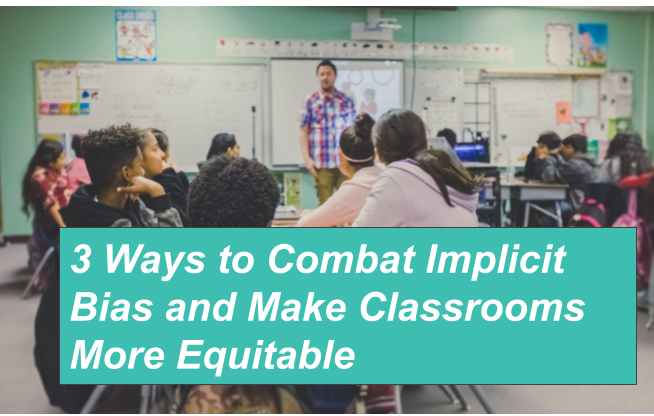3 Ways to Combat Implicit Bias and Make Classrooms More Equitable

Creating equitable classrooms starts with us, the educators. One of the best ways to begin is to combat our own implicit biases. This is a challenge, because implicit biases are... well... implicit. By definition we aren't aware of them. If you're unsure about your own implicit biases, consider taking one of many Implicit Association Tests1. There are many tests to choose from, which allow you to gauge your unconscious biases within areas such as gender, race, age, socio-economic status, religion, and more. If you're anything like me, it likely won't take long for you to be shocked by how many biases you have (but remember, they're implicit, so forgive yourself!). Once your shock shifts into a motivation to do something about your implicit biases, consider trying one of three strategies below.
1. Use Reflective Teaching to Improve Awareness
The truly sinister aspect of implicit biases is that, by definition, we aren't aware of them. So, any strategy that turns what is implicit into something explicit is a great place to begin. Reflective teaching is one such strategy. There are lots of ways to conduct reflective teaching2, but my personal favorite is to record a lesson with a camera that allows you to observe both yourself and your students. What should you look for? Consider lending a careful eye to where you tend to stand while you teach, to the half of the class you tend to look at the most, to which students receive the majority of your attention, and so on. Researchers have found that we tend to stand closer to and speak more kindly with those that we're most comfortable3. Once we become aware of our unconscious tendencies, we can begin to consciously change our behavior.
2. Self-Manage with SODA
Once we make a habit of observing our own behavior carefully for biases, we may need a self-management strategy to help create some space between stimuli and our reactions. Enter SODA, which comes from the National Equity Project4 and stands for:
Stop - pause before acting
Observe - be mindful of your thoughts and emotions
Detach - try to look at the situation through an objective lens
Awaken - shift to see another person's perspective
Once habitualized, each part of SODA can happen in the blink of an eye. By creating some space between stimulus and reaction using SODA, we can begin to act in ways that are more consistent with the people we intend to be, rather than falling victim to our implicit biases and the potentially harmful reactions they bring out in us.
3. Remove Unknowns by Expanding Your Network
The fancy name for this strategy is "Intergroup Contact" - which simply refers to the act of getting to know people that don't look and sound like us. Traditionally, most of us grow up around folks that share similar demographics with us, be it our race, our SES, or religion, etc. Not surprisingly, when we meet people from outside these groups, we tend to tread lightly. This is how implicit biases can form. The good news, though, is that by expanding our networks and really getting to know folks that may seem different from us, we can chip away at these biases. Research has shown that intergroup contact has led to a reduction in implicit biases over time5. And personally I have found that, time and time again, when I really get to know someone new, I discover just how much we have in common, no matter what our individual backgrounds may be.
To be sure, combating implicit bias is a lifelong endeavor. Success is measured over many years and thousands of interactions. But, if we really want more equitable classrooms, working to combat our own implicit biases is worth our time and effort.
Pete Grostic, Ph.D
Executive Director
Please join Math Medic Foundation in our mission to improve math outcomes for all. You can contact us to get involved or donate here.
Follow us on Twitter!
2 Reflective Teaching - Yale Poorvu Center for Teaching and Learning
3 Watch: Can You Affect Another Person's Behavior With Your Thoughts?
5 Intergroup Contact Throughout the Lifespan Modulates Implicit Racial Biases Across Perceivers' Racial Group - Kubota, Peiso, Marcum, & Cloutier
02/05/2023